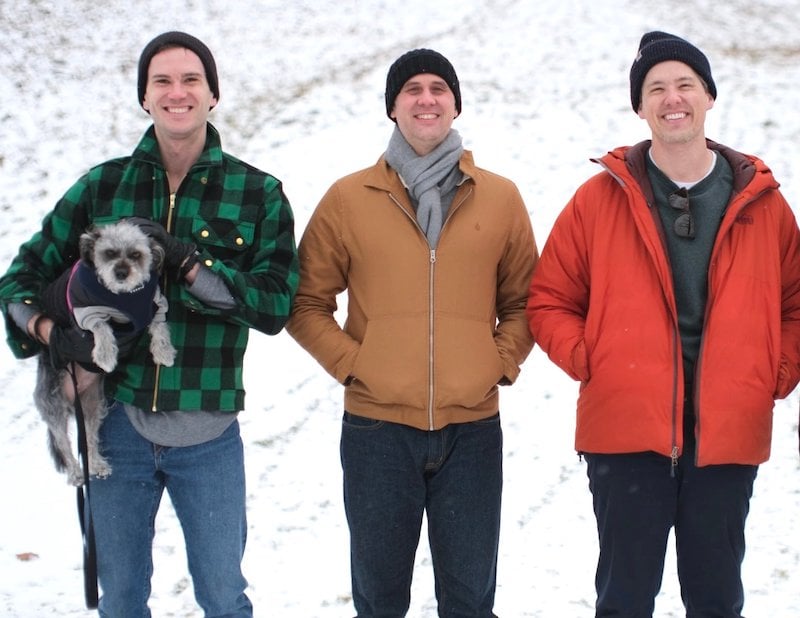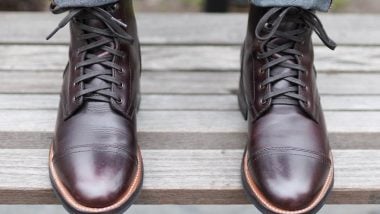Calf Leather vs Cow Leather – What’s Best for Your Boots?

Expert Verified By: Michael Batson, Vice President, North Star Leather Company
Especially popular with high-end English tanners like CF Stead and shoemakers like Crocket and Jones, calf leather is a mainstay in dress shoes. But what a lot of people don’t know is that despite its classy reputation, it can be tanned to produce a rugged, outdoorsy leather as well, like the one you’ll find on the Rhodes Dean Boot. With its reputation as a by product of the veal industry, deciding whether to purchase your first pair of calf leather boots or stick to regular leather can be intimidating. To help you out, we got in touch with Michael Batson from North Star Leather Company, who provided much of the information for this comparison between calf vs regular leather.
Note we’ll define “regular leather” or “cowhide” as leather that comes from older cattle regardless of their gender. Regular leather includes steer, bull, and cow. (A steer is a castrated bull, FYI.)
“I wouldn’t say calf vs ‘steer’, just because I’m almost never presented ‘steer or bull’ as some separate category of leather when I buy it,” says Batson. “I assume most leather is from steers, but I’ve only heard of one or two instances where they specify on the tannery level. The only that pops into mind is Red Wing’s Esquire leather, used in Caverly Chukkas, which comes from 3-year-old heifers. That’s a cow that hasn’t borne a calf.”
The age of an animal has striking effects on the nature of the leather. While they come from the same animal, calf leather and regular leather differ greatly.

What is Calf Leather?
Tanneries source calf leather from domestic cattle that are less than one year old. (At that point, it’s called “yearling” leather, as you’ll find on RM Williams Chelsea.) In Europe, a calf is defined as a bovine animal less than 6 months old. In any case, as with most leather, it is a byproduct of food processing: the animal’s killed for its meat, then its skin is used. (For some folks this makes for a fatalistic justification for buying calfskin boots: “The animal was already killed for its veal, it’s not like it was slaughtered for shoes, this is just making the most use of its body. It’d be worse to throw it out.”) Varieties of calf leather include calfskin (which we’ve been describing), slink, slunk, and Box Calf leather.
Calfskin and calf leather are general terms for leather from young cattle.
Slink/Slunk
Also known as Chicken skin or Mort, this is leather from unborn animals, and is not often used for footwear as it’s too thin. Valerie Cummings writes in her book Gloves that in the late 18th century, Slink was used in Irish Limerick gloves,
so fine and supple that they were often sold as a novelty, encased in a walnut shell, examples of these exist in various private and public collections.
Today, you find mostly slink jackets, vests, and gloves for sale in high-end fashion. There are only a few suppliers, as this is a very uncommon leather.

Boxed, Box calf, or Boxcalf
This is calf leather that has been chrome tanned with an aniline finish. As you can see in the post above of Francesco Lanzone Oxfords, it’s distinguishable by its smooth, glossy look. It is often rated as a high-quality leather that hasn’t been split, buffed, or corrected, and it’s very popular in men’s dress shoes. The aniline finishing process requires a pristine hide, as any defects in the hide become more noticeable after the finish.
Boxed calf leather is different from patent leather, which is sometimes referred to as a type of calf leather. However, patent leather is any fine-grained leather with a glossy look.
Where Does Calf Leather Come From?
Europe has some of the best-known tanneries that specialize in calf leather. For example, both Viberg and Truman Boots use the English tanner CF Stead’s calf leather. France has Tannery Haas, a sixth-generation tanner that specializes in calf hide. Tannerie dʼAnnonay is another famous French tanner specializing in calfskin, which is used at John Doe Shoes among other shoemakers. Both tanners have a very long history of providing high-grade leather for luxury brands.
[Related: The 5 Best Leather Tanneries on Earth]

Is Calf Leather Ethical?
The calfskin used in leather is primarily a byproduct of the European veal industry. Calves are raised for their meat, tanneries process the hides, and shoemakers use the hides to make shoes and boots. Calves used for veal have historically suffered inhumane conditions; specifically, the use of veal crates, poor nutrition, and limited natural lighting. In the European Union, veal crates were outlawed in 1996.
EU law was further refined with the Directive 2008/119/EC, titled “Minimum Standards for the Protection of Calves.”
“The Directive, amongst other things, sets out minimum dimensions for individual pens and for calves kept in group. Calves are not to be tethered (except under very specific circumstances) and must be fed according to their physiological needs. In particular their food must contain sufficient iron and a minimum daily ration and fibre food must be provided.”
While these laws are an improvement, many individuals and shoe companies, like Thursday Boot Company, still draw the line at using calf leather.
Then again, regular leather is also a byproduct of the meat processing industry and has its share of debatable ethical practices. The supply chain for cattle is globally distributed, and the treatment of individual cattle is difficult to gauge. Then there’s the environmental damage caused by large scale cattle farms — boot manufacturers and tanneries differ greatly on how they source and guarantee ethical treatment of their animals, but generally it’s a don’t-ask-don’t-tell attitude. (Kind of like how you don’t want to think too much about the life of the burger you just ate.)

The Price of Calf Leather vs Regular Leather
Calf leather is often more expensive than other types of bovine leathers. This is because it comes from a smaller animal and there’s not as much raw material to work with — the average calf hide is at most half the size of adult cattle. Tanner Haas’s box calf leather costs 139.00 USD for about 5-6 square feet. You can buy 5 times (19-20.9 square feet) that of Horween’s black Chromexcel for roughly the same price.
This is really to say that if you’ve got a piece of calf leather and cow leather from the same farm and the same tannery, the calf leather will likely be more expensive. But given the huge variety of how leather is sourced and tanned and corrected and turned into shoes, don’t take this to mean that calfskin shoes will always be pricier than cowhide shoes.

The Durability of Calf Leather vs Regular Leather
Generally speaking, calf leather is durable, especially for its weight and thickness. While thinner in variable, calfskin has a tighter, more even grain and because the fibers are closer together — ounce for ounce, calfskin is said to have more tensile strength than cowhide.
Now, if you’re dealing with chunky steerhide that’s twice as thick as calfskin, it’s a moot point, and more importantly the way a leather is tanned has a lot to do with the durability of the final product.
So “calf vs cow” is far from the only question to ask when assessing a boot’s toughness. There are too many factors that affect leather to accurately and consistently determine a baseline for durability. The thickness of the leather, how the leather is processed, how the boot is constructed, how the boot is cared for, and even the humidity while it’s in storage — all have a major impact on the lifetime of the final product. Common boot maladies like cracking, scuffing, and staining may occur regardless of the type of leather.
[Related: Why Is Cordovan Leather So Damn Expensive?]
View this post on Instagram
Appearance and Feel of Calf Leather vs Regular Leather
That said, the pore structure of calfskin is different from older cattle. Calfskin has fine, barely visible pores and a very smooth surface. The amount of hair pores on a cow is constant throughout their lifetime, and as the animal ages, the added bulk of the animal stretches the pores across its body. So calfskins have a higher density of smaller pores, resulting in a more uniform appearance, while pores on regular leather are usually more visible.
Calf leather also has a smoother grain than older bovine leather and it’s typically free of blemishes and scars because of the animals’ brief lives. This is why it’s more often used in dressier footwear.
Of course, cowhide can always be artificially smoothed, or “corrected,” to make it more uniform in appearance, but this doesn’t give the precise same appearance of naturally smooth calfskin.
“Differences in calf versus cow have a lot more to do with how it’s tanned, it’s impossible to make too many generalizations,” says Batson. “For example, I buy scrap from Alden. In that scrap I have some very stiff — thin, but dense — cowhide leather that you’d find in high end dress shoes with a semi glossy finish. I also get a leather with a similar look and feel embossed with Alpine grain. On the opposite end, I have some Janus Calf from CF Stead, used in their full grain suede shoes, that’s soft and floppy with a completely matte finish. I also have Calf from Tannerie H.A.A.S. that has a nice buttery feel, and it’s available in both plain and embossed.”
Wrapping Up
Calf leather’s fine grain and blemish-free appearance make it a favorite for dress and formal wear. Aesthetically, there are plenty of alternative, regular leathers out there for just about any style you can find in calf, and there are more rugged calfskin options too. But, for those looking toward the far end of dressiness and price, there aren’t a lot of regular leather substitutes for box calf leather, unless you want to get into equine leather and pick up a pair of Shell Cordovan.










Well done, thank you for a bit of knowledge.
Appreciate it Martin!